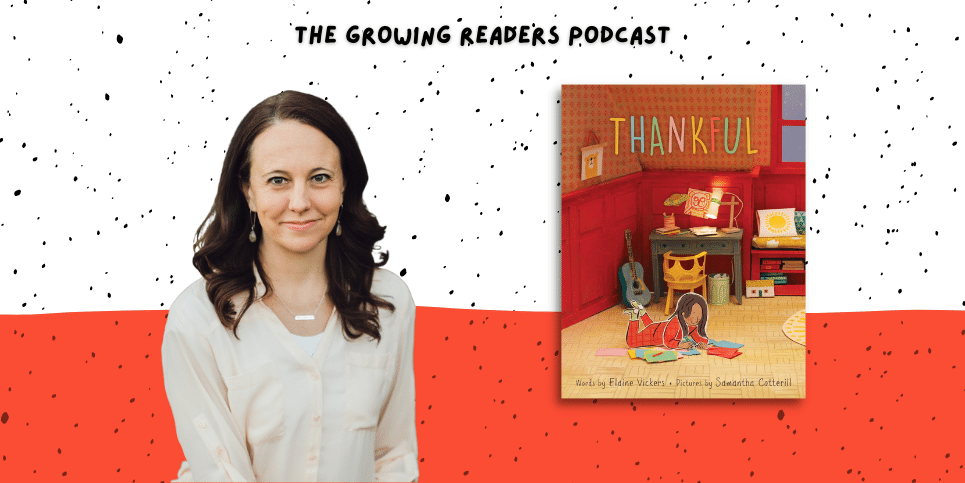An interview with Elaine Vickers
The Children’s Book Review
In this episode, I talk with acclaimed author Elaine Vickers about her tender picture book Thankful.
Elaine is the author of the middle grade novels Like Magic and Paper Chains, which have received starred reviews, Whitney Award nominations, Mighty Girl’s Book of the Year picks, PJ Library licenses, and sold translations in four languages. She is also the author of the YA novel, Fadeaway. In her non-writing life, Elaine teaches college chemistry, and she lives with her family in Utah.
In this conversation, we dig into the topic of gratitude and the making of Thankful, in which stunning, diorama illustrations bring to life this lullaby of a picture book about celebrating everyday things that make life wonderful. Get ready to have your heart filled!
Listen to the Interview
Read the Interview
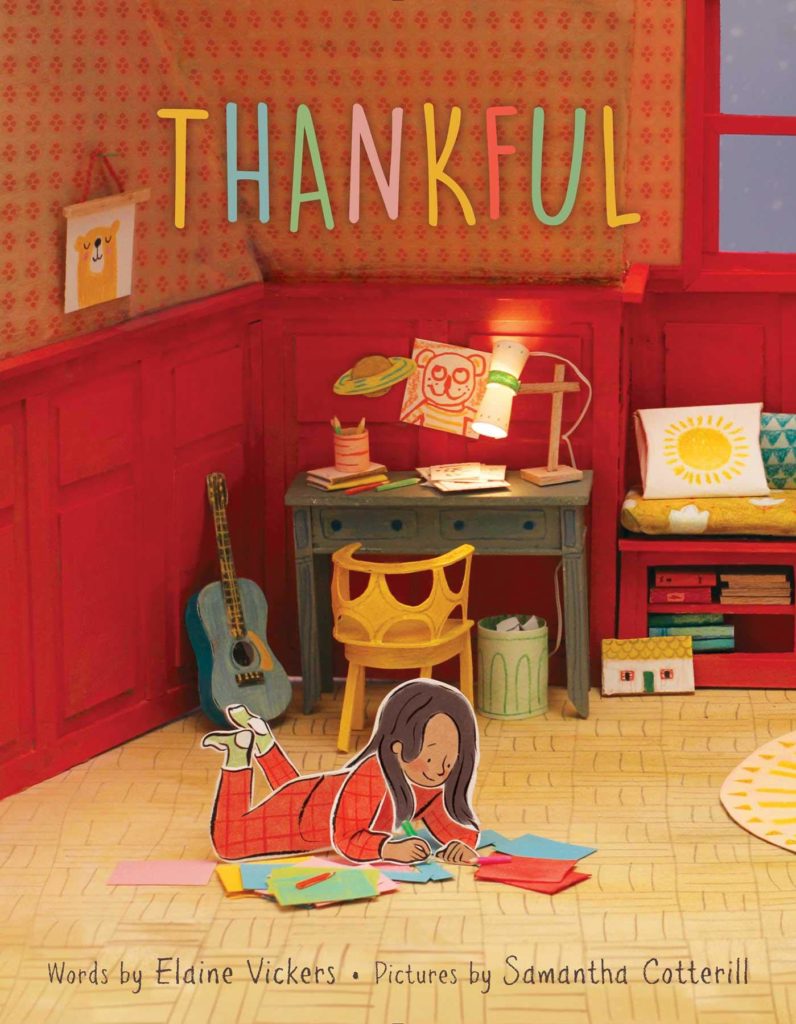
Bianca Schulze: Hello, Elaine. I am so grateful to be able to talk to you today about your picture book Thankful. I just believe that the mindful act of practicing gratitude is so beneficial to all of us, and so I’m thrilled that your book so beautifully demonstrates the art of being thankful.
Elaine Vickers: Oh, I am so grateful—or I should say thankful—to be here talking about Thankful, and I think you’re right. My day job is that I am a scientist, and as a scientist, I support other scientists. Science shows that a regular practice of gratitude, whether it’s just a verbal thanks to people who have done something or even just mulling it over in your mind, can be a powerful thing that changes our lives and makes us happier and healthier. And of course, that is a big part of what thankful is about is one way that classes and families, and other groups can practice gratitude and take a minute and stop to think of all the things that they’re thankful for.
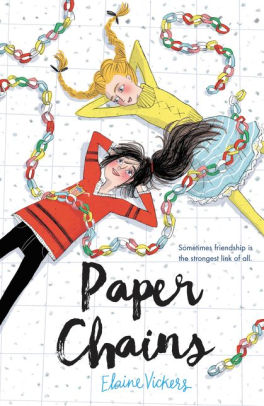
Bianca Schulze: So, before we talk more about your book, I think we need to give a special nod to your middle grade novel paper chains for inspiring it. So, I’m hoping before we talk about Thankful, which is a picture book, that you could just share a little bit with our readers about paper chains, which I’m going to say we picked as a ‘best book’ back in 2017 on the children’s book review. Anyway, share a little bit about Paper Chains and how it led you to write Thankful.
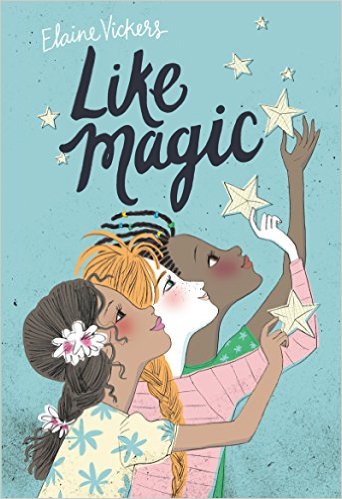
Elaine Vickers: I remember that and thank you so much for your support of Paper Chains back when it came out. I’m going to take one step further back. My first book was called Like Magic, and it’s about three girls who feel lost and alone for different reasons and how art kind of connects them. And one of the girls is feeling kind of lost and alone because her best friend has just moved away. And the best friend who has just moved away is Katie, the main character in Paper Chains. So, I always seem to write books that are connected in one way or another.
But yeah, Paper Chains is about Katie and the new best friend that she makes when she moves to Boston. And one of the things that Katie’s family does is that every year when the first snow falls, they make thankful chains, which I may have picked up somewhere throughout my life, or I may have created them from my imagination. But what her family does, their tradition, is that when the first snow falls, they write down all the things they’re thankful for on strips of paper, and then they turn them into paper chains. Every night, they gather as a family. They each take a link off their chains and read the things that they’re thankful for. They are reminded of all they have to be grateful for in their lives.
And when I wrote this book and turned it into my brilliant editor for these novels, Amelia Rhodes said, What a great idea and a fun tradition. Do you do this with your children? The thought had never crossed my mind to do this with my three actual children that live in my house. But of course, after that, I thought, well, yeah, we should do this as a family. So, beginning that year at Thanksgiving, we gathered the kids and some of their cousins, and they did this in real life and wrote down the things they were thankful for. And it was so fun and rewarding.
The things some of the things they wrote I expected and other things just really blew me away. Some were random and funny, and others were just thoughtful and unique, and it was so fun to see where their little minds went with this. I’ll be honest, we’ve missed a few years, but we’ve done it as a tradition in our family since then, and it’s been so fun, like I said, just to see what the kids come up with.
Bianca Schulze: Can you recall off the top of your head what was one of the more unexpected things they would think before?
Elaine Vickers: For some reason, it’s the random ones that are coming to me. They will have very specific food items that they’re thankful for, but some of them were meaningful memories. I’m thankful for the time we laid on the grass and looked at the stars like that kind of a thing that had happened months ago that I wouldn’t have even thought that they would necessarily remember.
Bianca Schulze: Yeah, that’s beautiful. Ok, sorry, I cut you off before. So, as you were …
Elaine Vickers: So, we were doing this with our family, and it was kind of surprising and meaningful, and it was a little bit meditative for them as they did it. And I think it did do what I mentioned earlier. I think it served to help them practice gratitude, which makes us happier and healthier. I found that Just Like Magic connected to Paper Chains; maybe I needed another book linked to this one.
The first picture book I ever wrote was in fifth grade. It was a counting book, and I illustrated it myself, and that was the first time I ever felt like maybe I would like to be an author. And then I forgot about that dream for a while, and then I picked it back up later when I had kids of my own and was reading a lot of picture books with them. So, I started not with middle grade novels but thought I’d be a picture book writer. Picture books are hard, you know. You have to tell the whole story and have character development, and everything must be encapsulated in about five hundred words or less. And I wrestled with that for a while, and it was my middle grade novels published first.
But I never gave up on picture books. And when I wasn’t quite done with this idea of these things will change. I thought, maybe there’s a picture book in there. I thought back to some of the things my kids had written and about some of the things that I’ve been thankful for in my life. I turned it into what is now Thankful, my debut picture book. Ten years after I started seriously wanting to write picture books, here it is.
I can’t overstate how thankful I am for the way that it all turned out. It landed with the perfect editor at the perfect imprint of the perfect publisher for this book. And then I feel like the very most perfect part of this book is the illustrations. They are incredible. And when I first heard that the illustrator was going to be a 3D illustrator, I should have known what that meant. But in my mind, I thought, does that mean that’s going to be a pop-up book? And, of course, that isn’t what it means at all.
In this case, it means that Samantha Cotterill, who is just brilliant (and you should buy all her books—she’s incredible), created every scene, and she makes every detail. You’ll notice even the endpapers are gorgeous. She built hundreds of tiny books for this one scene and, with tweezers, linked all the tiny, tiny paper chains together. She builds the scenes with the characters, then takes a picture, and that 3-D set becomes the illustration for each page of Thankful.
So that’s kind of the story of the origins of the book and how this book came from paper chains, which incidentally takes place between Thanksgiving and New Year’s. So, it’s the perfect book to read this time of year.
Bianca Schulze: Since you are gushing on Samantha’s artwork, she is incredible. I love the little, teeny tiny notes at the beginning of the book, and it says each spread is hand-built, three-dimensional sets photographed with a digital SLR. And there’s just so much detail. It’s amazing. And then the expressions that the characters have as well are incredible. So, I am 100 percent with you. The artwork is outstanding.
Elaine Vickers: Yes, absolutely!
Another thing that I want to make sure to talk about is how she makes all of this with stuff that both of us and the listeners and kids, most importantly, probably have around the house. There’s an adorable car in the book that I know is made from a cereal box. She uses the crayons that she had left over from when her kids were younger. There’s a spread where kids are riding their bikes, and she very deliberately left an exposed edge of the cardboard in that spread. And I’ve heard her say that she does this on purpose, of course, so that kids will look at the art and they will think to themselves, I bet I could do something like that, which I believe is so phenomenal. She is just absolutely a dream to work with. The car is one of my favorite pieces.
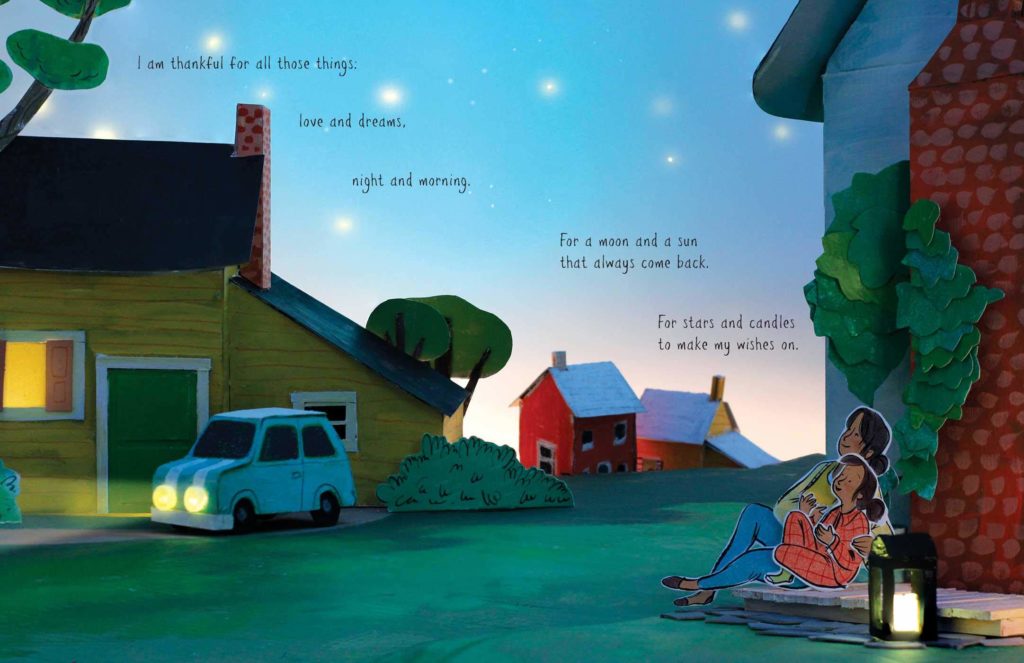
When I first read this book with my daughter Lucy, who was 10, she said, I just want to climb in there and live there. I feel that too. It’s just this magical world that she’s created. I asked her once, what is the weirdest thing you’ve used for an illustration? And I guess the doorknobs are made from gum. She didn’t have any clay at the time, so she just used gum and made it into a doorknob.
Bianca Schulze: That’s amazing.
Elaine Vickers: It is all just kind of regular things you would have around the house, and then she turns it into these incredible pieces.
One of my favorite set pieces in the book—I love the characters, but one of my favorite set pieces—is the house. You never actually see it, but I think there’s a picture of the entire house if you go on Sam’s website. There isn’t a picture of the whole house in the book, but you can see glimpses of it. And in the original sketches for the book, you saw the entire house.
One of the things that I talk about when I visit schools is that my grandma lived about a block away from my elementary school when I was growing up. Every day after school, I got to walk to her house, and she was sort of a magical person in my life and that she would have an after-school snack for me. But she would sometimes make a treasure hunt. So, I had to follow the clues to find the after-school snack. She was remarkable.
Well, this was kind of a magical place in my childhood, and I’m from southern Utah. Sam is from upstate New York. We’ve still never met in person, and somehow the house in the book, and I’ll get a little bit emotional when I say this is almost exactly my grandmother’s house. And when I first saw that, I just really did get emotional; it took my breath away. This book feels so magical to me in so many ways because of Sam’s art, and that’s what’s especially special to me.
Bianca Schulze: Oh, well, honestly, I’m going to say between the words and the artwork that Thankful is so stunning, and it gives me all the feelings that you could hope that one book could give you. And I don’t even have that magical personal connection that you have. But when I finished reading it for the first time—and as I said at the beginning, it’s so important to practice gratitude—I had that full-body kind of feeling. I felt happy. It’s poignant, too. So, I think it’s beautiful.
I’m curious if there was one impact that you hope that this book would have on readers. What would that be?
Elaine Vickers: Yeah, let me give you one that I hoped for and one that I didn’t necessarily envision; that’s been wonderful to hear. So, I think I hoped that this would be something that caught on. Sam is funny and says, we are going to replace Elf on the Shelf. That’s the tradition, the thing every family does. I think that’s a great vision, and it’s a lot less creepy. So, I hoped that it would be something that would catch on—not for any personal gain, necessarily—I think it can be a powerful way to look at all that we have to be thankful for. And a fun thing! My kids had a blast doing this with their cousins. So, I think it can be a fun and meaningful thing for families and classes to do together.
The unintended and remarkable thing is I’ve had a couple of readers who have reached out and said: I just went through something fairly traumatic in my life, and I found myself reading this book over and over again and reminding myself that I do have things to be thankful for, that it will be OK.
A page toward the middle of the book says, I am thankful for a heart that beats and every breath in and out, in and out. And I think it’s something that maybe I will come back to when I encounter those moments in my life. If you compare it back to things feel hard right now, but I have these things to be grateful for—I think that can be powerful. That was something that wasn’t at the front of my mind or even on my mind when I wrote the text. But I’m grateful that it’s impacting readers in that way.
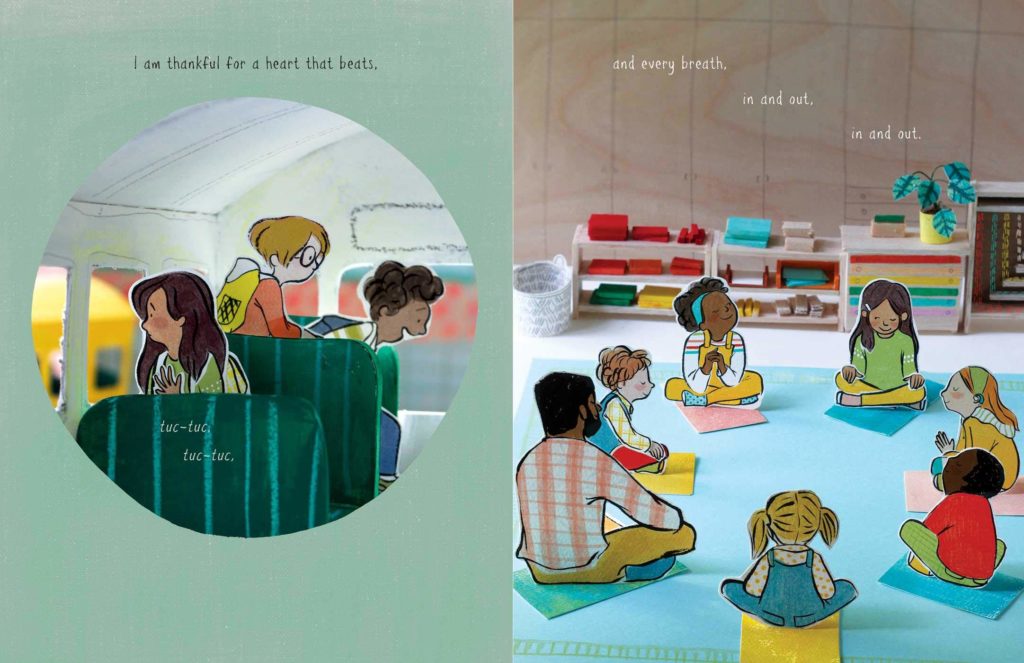
Bianca Schulze: This is a book that I think is great for all ages. I love that you’ve had these adult readers themselves come to you and tell you how it’s helped them in a hard time. But I love that the opening lines of this book identify that sometimes it can be hard to think of all the things we have in our lives to be thankful for.
Sometimes it’s just because we’re so busy to stop and practice and think, ok, what am I thankful for? It can seem trivial, but then how do you get beyond that? But also, what you said, if you’re going through a tough time and for the analogy, you’re in the dark tunnel, and how do you see that light at the end? How do you see the things that you’re thankful for? Well, I want to say that a book like this is perfect for helping you know what you can be thankful for.
But I’m curious because you did identify at the beginning of the text that it can be hard to think of all the things to be thankful for. What was the experience you had coming up with all the beautiful things included in this book?
Elaine Vickers: Oh, I love that question. Yeah, I did. I did try to do some of it based on what my kids had said. And I love that you brought to our attention that it is sometimes hard to think of what we’re thankful for. I noticed that with my kids when we did it, all the kids, my kids, and their cousins cranked out about ten things quickly. And then, when it got away from things that we always say we’re thankful for, it got harder. And I think there’s a lot of value in that, like really making yourself think of all the things you’re thankful for.
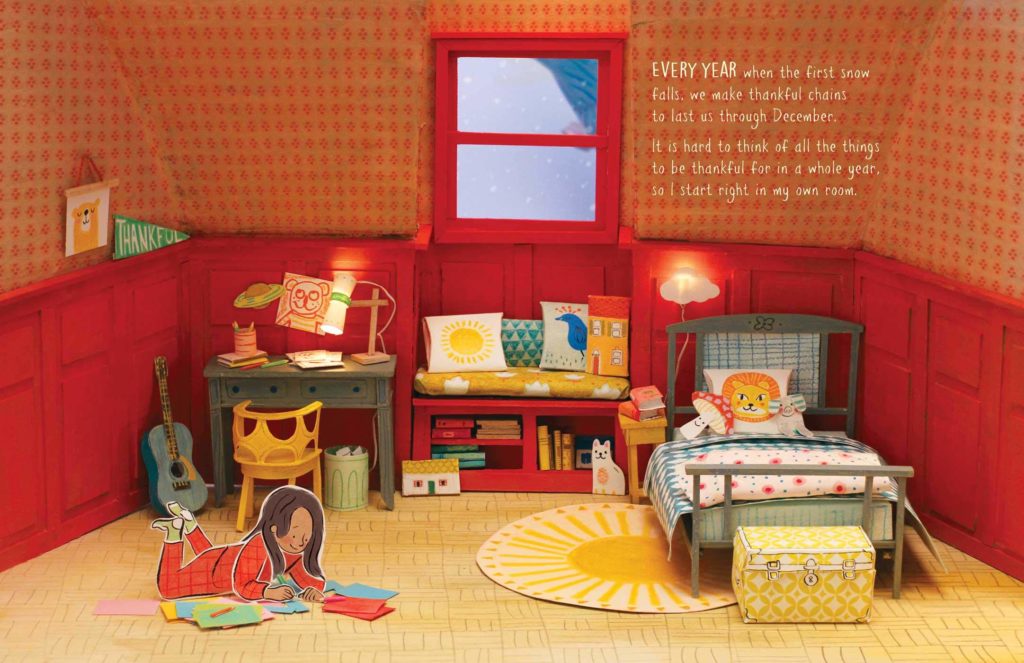
Bianca Schulze: I’m sure to start with that you had a certain list of things you knew you were going to include, but to make the picture book just right and have unique things to be grateful for. What was that experience like for you coming up with this complete rounded list?
Elaine Vickers: I did just open an empty word document, and I made a list as long as I could, knowing that I’d come back and make it better. I’ll curate this list later. Just everything I could think of. I did crowdsource it a little bit. I put a post out on Facebook and Instagram and just asked people about the simple things they are thankful for—I didn’t end up using anybody’s directly. That was also fascinating to see the adults in my life, and a lot of them asked the kids in their lives as well. What are you thankful for? That maybe would be simple but unexpected, and those were great answers. And so, I added those to the list.
Then it came back to that sort of curation revision stage where I had a long list and then formed it into a cohesive, cohesive story. I wanted it to be centered around one character. I wanted it to be a character who was doing this in a family setting, even though I certainly hoped that there would be classroom applications for this. And I also wanted the line after the one we just read. It’s hard to think of all the things to be thankful for in a whole year. I wanted the text to take us both from the child’s room out into the wild, wider world and then back to the child’s room, but also to take us from this moment when the first snow is falling and winter is beginning, to throughout the year.
So, it was a little bit of a challenge to find the right things from the list. A lot of them changed even in that stage to meet both of those goals and to do it in a way that I really wanted this book to be accessible for all kids and not to say the things that super privileged kids perhaps have to be thankful for but to focus on the things that so many of us have to be grateful for. I mean, the kids in the story do have a bike, so there are certain elements that I thought were perhaps universal enough to include them. That was part of the goal and the process. Create a giant list, imagine the framework that I want my items to fit in, and then sort of weave them all together around that framework.
Bianca Schulze: So, there’s a poem that begins and ends Thankful. Would you be willing to share that poem?
Elaine Vickers: Yes, yes. And the story behind the poem? Very, very glad you asked that. The dedication for Thankful, Sam’s dedication is For you. She has expressed that this is for all the readers and her gratitude for you, for everybody who reads the book. My dedication is For Mom and Dad. Whatever tomorrow brings, I love you. And that is a direct tie to this poem that you mentioned.
I had this magical grandma that I mentioned. I also had incredible, supportive parents, and they would tuck me in every night. And I think my dad start started it, perhaps. But they both ended up adopting this little phrase that they would say every night when they tucked me in, which was: Goodnight, sweet dreams. See you in the morning. I love you.
That was a big part of my childhood. I think that that tiny ritual made me feel so safe and loved every night, so I wanted to incorporate that. I wanted this to be a very, very cozy book with that you-are-safe-and-loved kind of a feeling. I brought a version of that in here, so:
I am thankful for parents who read me stories and brush my hair gently, gently.
Who whisper the same poem every night when they tuck me in.
So, here’s the poem, and you’ll notice it’s not exactly what my parents said, but that certainly inspires it:
Good night, dream sweet things,
let them carry you on their wings,
and whatever tomorrow brings.
I love you.
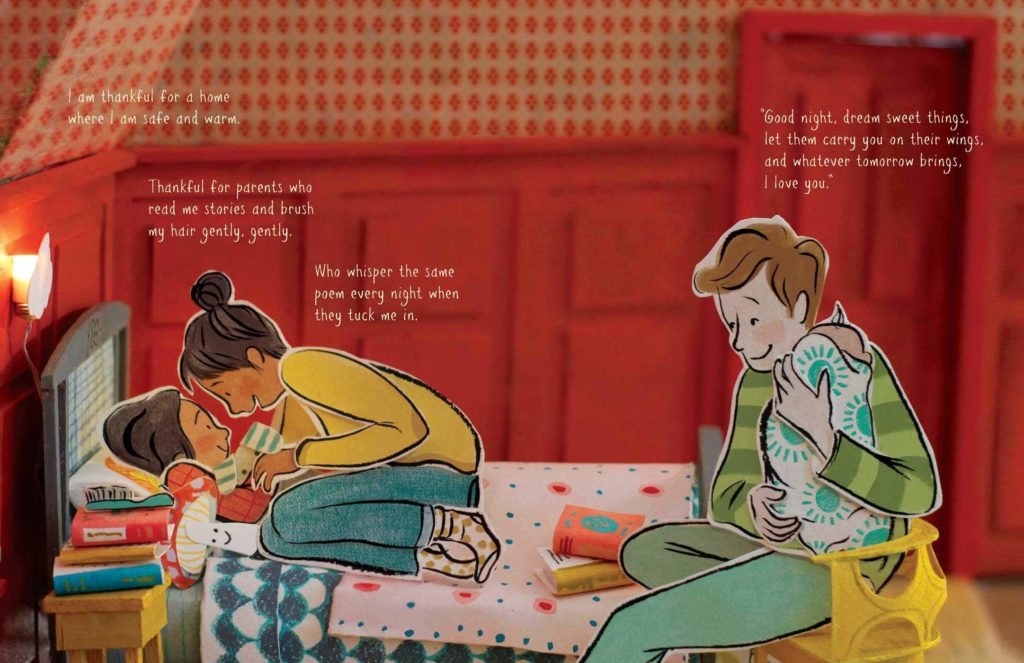
Bianca Schulze: I love that.
Elaine Vickers: Thank you. That’s one of my favorite parts.
Bianca Schulze: It’s something that your parents did for you. And then you’ve elaborated on this poem, and I know you have three kids. So, do your three kids like you to read this poem to them now?
Elaine Vickers: My youngest does very much. My older two are 16 and 14, so not so much, right? So, I still go in and say goodnight to them, but sometimes they’re still wrapping up homework or whatever. So, we do have maintained the ritual of we’re going to have just a little moment together every night. Yeah, they’re not as enthusiastic about the poem itself.
Bianca Schulze: So, you have one young adult novel?
Elaine Vickers: Yes.
Bianca Schulze: Two middle grade novels. Wait! Your young adult novel is forthcoming. Is that correct?
Elaine Vickers: It came out in March.
Bianca Schulze: Oh, my goodness. That’s amazing. I’m so curious because I was reading that you had a young adult novel, and then you’ve got the two middle grade novels. And then we were talking about the picture book. Tell us about your young adult novel. But I really want to know just in general what drives you to create books for kids and teens?
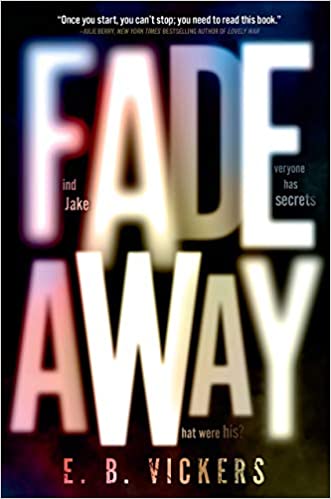
Elaine Vickers: Yes, yes, absolutely. So, the young adult novel is called Fade Away. This one is with a different editor and a different publishing house; we decided early on that it is different enough from my other books to publish it under E.B. Vickers. So, my initials rather than Elaine Vickers, just so readers wouldn’t pick up the sweet, charming middle grade and then go immediately to kind of a darker, grittier, young adult novel that has some hard things in it.
It is a novel about student-athletes and addiction and deals with some challenging, heartbreaking situations, so we wanted some differentiation there. And I will also say that the books came out within six months of each other, and it has been an adventure to promote both the dark, gritty young adult suspense and the, you know, heartfelt, uplifting, thankful. And I mentioned earlier the three books published under Elaine Vickers that are very much tied to each other.
So, yeah, I think that’s a great question. What is the connection between Fade Away? This young adult novel and the other books that I’ve written. This was something that, as I was revisiting my website, I needed to think about. Like, what is the thing that ties all these books together? My web designer forced me to have that conversation with myself and reflect on that. And here’s the sentence we came up with for the website:
Elaine or E.B. Vickers is an award-winning author of Picture Books, Middle Grade, and young adult novels that aim to help readers of all ages find connection and belonging.
I think that is an underlying reason for everything I write. It breaks my heart to think of kids feeling isolated, to think of kids feeling like they are not enough, and they are okay, just as they are. And so, I think that is a big part of why I do what I do and what I’m hoping readers will take from everything I write—whether it’s the happy, cheerful picture book all the way to the darker young adult books.
Bianca Schulze: Well, so besides being an author, you also mentioned before that you wear the hat of a scientist, a teacher, and you’re a mom, so talk about wearing all the different hats, and maybe what it’s like to wear more than one hat at a time.
Elaine Vickers: Yes. Yeah, there are seasons where it feels really like a lot. And to be honest, if things hadn’t developed in the way they had developed, I don’t know that I would have that. I would have thought where I would have believed that, that I could do all those things. The about the author, parts of my middle grade novels, the section on the jacket says:
She always wanted to be a writer and a teacher, except when she wanted to be an architect and artist, a pediatrician, a judge, or a famous actress.
That is how I felt at the time. It wasn’t that I wanted to be all those things sequentially, necessarily, but I wanted to be all those things all the time. And as I grew up, I feel like I sort of got the idea that, no, you must choose one. You must choose the one thing that you want to be when you grow up.
So, I did narrow it down at one point: I’m going to be a chemist, I’m going to be a scientist. And then, through some great mentors and friends and family members, I let go of the idea that I needed to choose one thing. And so, it did just kind of develop that I always knew I wanted to be a mom. I defended my dissertation eight months pregnant with my first kid, so I always knew that those two things would be in there. But then, yeah, just little by little, things sort of started to add themselves organically to the mix. Of course, once I became a scientist, I did want to be a teacher.
And then I was so excited about the books that my kids were reading that I started to think, well, maybe I would like to try writing books. And then my position at the university has sort of evolved into an administrative role a little bit too. And part of what I get to do is to help bring STEM—science, technology, engineering, math—education to kids in rural Utah that maybe don’t have as much access to that.
So, it is wearing a lot of different hats on any given day, and I really can’t imagine any other way. I mean, there are days when it’s a little bit much, and I may steal back on certain aspects of things moving forward. Still, I do feel so fortunate that I was able to move on from that mindset thanks to the people I mentioned of having to choose one thing that I wanted to be and to be able to do all these things that I really, really love and can connect with people in all these different ways. It’s a very, very lucky life that I lead, and I’m lucky to have the support that I have.
Sometimes I get the question of how do you do all these things? And the answer is that I have my parents in town, my husband’s parents are in town. He is wonderful. My kids are great. I have awesome colleagues at the university and teaching assistants. And the reason I can do the things that I do is that we have so much help, and I am so, so grateful for all of them.
Bianca Schulze: I love that you just managed to weave in the aspect of gratitude in there, too. It is so fitting.
Elaine Vickers: Oh yes, it wasn’t intentional. But yeah, I feel it.
Bianca Schulze: That’s amazing. I feel like just being a mom—a parent—is enough, right? You know, raising humans. And so, I just want to personally thank you for writing a book such as Thankful. And I wonder, too, if all these different hats that you wear, that is what enables you to be able to write from such a special place because you’ve had different experiences. And anyway, I love that message, too, that you don’t have to just be one thing.
Elaine Vickers: Yeah, I’ve heard it phrased, and I wish I could cite a source here. But I’ve heard it phrased as rather than asking kids what they want to be when they grow up, let’s start asking them who they want to be when they grow up and help them build a life that supports that full human of all the different aspects of who they want to be. And I wish I could remember where I got it from.
Bianca Schulze: Yes. Oh my gosh. Well, if you think about it, we can add it to the show notes. If not, somebody else could message us if you know who said that. Let us know.
All right. So, here’s my question that I like to ask everybody. They say, to be a writer, you need to be a reader first. So, was there a pivotal moment for you in which you considered yourself a reader?
Elaine Vickers: Oh, I love that question. I don’t know whether I remember a moment, but I absolutely know the book or the series that did it. It was the Ramona books by Beverly Cleary.
I remember just reading those books, and I wouldn’t have used these words for it necessarily then, but I just felt so seen. Here is a kid who messes up, and her family loves her anyway. Here is a kid who is the younger sister and sometimes feels like she’s in the shadow. Here is a kid who is having these real experiences. You know, she’s not sure about her Halloween costume, and she’s not sure she or her teacher likes her all the time. And just everything about that pulled me in and made me feel so seen and felt so real to me. And I tore through those books, and then I read them again and again and again.
And it’s been fun the last couple of years—earlier, I mentioned my youngest daughter, and we have been reading the Ramona books. Overall, besides some small things throughout, I just feel like they resonate so well. And even with those little bits, I read that with my daughter and talk about how times have changed and how maybe a better way to think about those small things. It’s been so fun and rewarding to read those with her and to have her begging to read the next one to two and to have those same books shaping her as a reader. Now it’s just really kind of wonderful.
Bianca Schulze: And the way you just described how the Ramona books were for you as a kid and how they are for you now reading with your family, I just want to say that your books are doing that for people now. And I think that’s so magical. And so, I really do believe that to be a writer, you must be a reader first because what you said is what your books are doing.
Elaine Vickers: I appreciate that so much. Wow, thank you.
Bianca Schulze: So, I would just like to say that I am one hundred percent convinced that Thankful will inspire plenty of families and classrooms to start a new tradition or even a version of their own. In your book, it’s the paper chain, but you could take this book Thankful and pair it with any kind of activity that encourages kids to be grateful. And you know, for those kids that may be struggling with not knowing what to write—what am I thankful for? —it’s totally fine for them to take one of the ideas from your book, and then their ideas will blossom. You know, they’ll start to be like, oh, that’s right, I can be thankful for something as simple as the snow falling.
Anyway, Thankful is beautiful, so I cannot wait for families and classrooms to just embrace your book.
Elaine Vickers: Oh well, and I love what you said: There are so many different ways …of course, making the paper chains is one of them. I did my first school visit last week since the pandemic started—my first in-person rather than Zoom school visit—and right before I went to get a snack so that I would have lots of energy and the little cafe had a turkey on the wall. They were asking all the customers to write something they’re thankful for on a feather for the turkey.
Bianca Schulze: That’s just perfect.
Elaine Vickers: There are so many ways to make this work, and since you mentioned the idea of different activities to do with families, I will just give the little plug that there are free printable activity guides on my website and Sam’s website as well (www.elainevickers.com/books/thankful/ and www.samanthacotterill.com/resources.html) and they’re adorable. Sam brought her 3-D art to the printable activity guides, and there are lots of fun, even math activities and art activities for kids to do related to the book. So, check those out and print those out. They are adorable!
Bianca Schulze: Oh, that’s great to know!
Is there anything else you think we need to know about your book or just the art of practicing gratitude?
Elaine Vickers: Well, in the vein of practicing gratitude, I do just want to give a shout-out to everyone who has embraced and supported this book so beautifully already, including you. I’m so grateful to be having this conversation here today. Today, I just got word from my editor that they are doing a rush reprint of Thankful because they’re almost gone from the warehouse. So huge thanks to everyone who has already supported this book. It’s just really been an overwhelming experience to see people just embrace it so fully and to get that message of gratitude out into the world. And I am so, so thankful for it. So, thank you.
Bianca Schulze: Thank you, Elaine. We are so grateful for both you and your book.
Elaine Vickers: Oh, my pleasure. Absolutely. Thank you for the wonderful conversation and questions. I appreciate it so much.
About the Book

Thankful
Written by Elaine Vickers
Illustrated by Samantha Cotterill
Ages 4-8 | 48 Pages
Publisher: Simon & Schuster/Paula Wiseman Books | ISBN-13: 9781534477346
Publisher’s Synopsis: Stunning, diorama illustrations bring to life this lullaby of a picture book about celebrating everyday things that make life wonderful.
I am thankful for a home where I am safe and warm.
Thankful for parents who read me stories and comb my hair gently, gently.
Who whisper the same poem every night when they tuck me in.
When the first snow falls, a little girl writes down the things she’s thankful for on strips of paper and links them together. As one idea leads to another, her chain grows longer. There’s so much good in her life: a friend, things that are warm, things that are cold, color, things that can be fixed. This beautiful story is a much-needed reminder to observe and honor life’s small joys.
Buy the Book
Show Notes
Visit Elaine Vickers at https://www.elainevickers.com/.
You can find the links to the activities discussed in this episode here https://www.elainevickers.com/books/thankful/ and here https://www.samanthacotterill.com/resources.html.
Thank you for listening to the Growing Readers Podcast episode: Elaine Vickers Discusses Thankful. For the latest episodes from The Growing Readers Podcast, Follow Now on Spotify. For similar books and articles, you can check out all of our content tagged with Elaine Vickers, Gratitude, and Picture Book.

